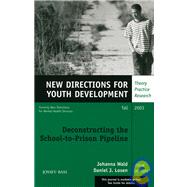
Note: Supplemental materials are not guaranteed with Rental or Used book purchases.
Purchase Benefits
| Editors' Notes | 1 | (2) | |
|
|||
| Executive Summary | 3 | (6) | |
| 1. Defining and redirecting a school-to-prison pipeline | 9 | (8) | |
|
|||
|
|||
| 2. Predictors of suspension and negative school outcomes: A longitudinal investigation | 17 | (18) | |
|
|||
|
|||
| 3. Connected in Seattle? An exploratory study of student perceptions of discipline and attachments to teachers | 35 | (20) | |
|
|||
|
|||
| 4. Punishing dangerousness through preventive detention: Illustrating the institutional link between school and prison | 55 | (16) | |
|
|||
|
|||
| 5. High-poverty secondary schools and the juvenile justice system: How neither helps the other and how that could change | 71 | (20) | |
|
|||
|
|||
| 6. Deconstructing the pipeline: Using efficacy, effectiveness, and cost-benefit data to reduce minority youth incarceration | 91 | (30) | |
|
|||
|
|||
| Index | 121 |
The New copy of this book will include any supplemental materials advertised. Please check the title of the book to determine if it should include any access cards, study guides, lab manuals, CDs, etc.
The Used, Rental and eBook copies of this book are not guaranteed to include any supplemental materials. Typically, only the book itself is included. This is true even if the title states it includes any access cards, study guides, lab manuals, CDs, etc.